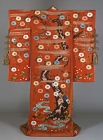Japanese Gallery (Honkan) Room 9
March 9, 2010 (Tue) - May 16, 2010 (Sun)
Watching Kabuki was said to be one of the three greatest popular pastimes during the Edo period (1603-1868), and the women of the time greatly admired the costumes of Kabuki performers. Despite its popularity in the towns, however, Kabuki was forbidden to the wives and daughters who lived in the inner chambers of shogun and daimyo residences. Nevertheless, watching Kabuki plays still counted as one of the pastimes of these women, just as for ordinary townsfolk.
Kabuki actors are traditionally male, but as very strict limits were placed upon the comings and goings of men within the inner chambers, in these environments it was performed by female actors known as o-kyogenshi. The majority of Kabuki costumes from the late Edo period in the Tokyo National Museum collection were worn by Bando Mitsue, a female student of Kabuki performer Bando Mitsugoro III and an o-kyogenshi. Bando Mitsue was particularly patronized by Senko'in, mistress of the 11th-generation shogun Tokugawa Ienari, and their daughters Yohime and Suehime, and the many lavish costumes she left behind illustrate the extent of her activity.
This exhibition features a selection of Bando Mitsue's kabuki costumes, including those worn during a performance of "The Maiden at Dojo Temple" for Rensho'in, wife of Hosokawa Naritatsu, the 11th-generation ruler of the Kumamoto domain. "The Maiden at Dojo Temple" is set in spring, and is traditionally associated with the cherry blossom season. Also on display is a long-sleeved furisode kimono with cherry blossom designs, used in Kabuki for princess roles. The heavily ornate embroidery, bold motifs and bright colors of these costumes provide a glimpse into the enchanting world of Kabuki.

